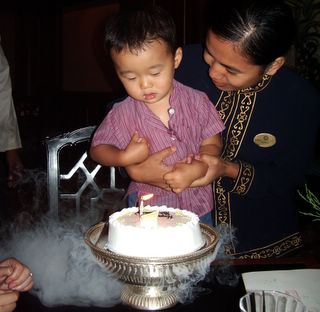Without question, one of the most enjoyable things about being in
Monday, May 30, 2005
Mango
Thursday, May 26, 2005
Temper
For me, to say that one ‘loses their temper’ is a misnomer. In fact, what is much more accurate, albeit a subtle difference, is that you FIND it. Tucked deep away under the multiple layers of socialization and discipline, it is rare to find a situation where this emotion emerges without some degree of associated damage that you later feel terrible about—an unwelcome visitor, the vestige of some unresolved issues, and ripe for armchair psychoanalysis. As someone who has a closer relationship with their temper than most (read: I certainly haven’t lost it, as I know exactly where it is), one aspect of my parenting has been to try and demonstrate to Kaia a more calm and peaceful way to approach problems and situations. As many parents know, children learn so much from just watching you behave. Sure words matter, but young kids really get the adage, “I judge not by what you say, but by what you do”. For me, one of my fears is that Kaia will find that his temper is often close at hand as well.
Over time, of course, like any good subject ruled by the panopticon, my temper made like Smeagol and ran from the light of good behavior, driven down into the bowels of a forgotten land. Of course, from time to time it would emerge, fed by impatience and lack of sleep, but for the most part it was controlled and in its place. That is, until I came here and, like Bilbo Baggins, something in the cultural winds has blown the tempers’ core out of hiding. It has been refound.
The incident that catalyzed the re-emergence was the culmination of a series of frustrating episodes that were lathered up from a 100 degree heat. Kaia has never been able to nap without being carried or driven in a car and, because our ‘new’ car (notable for its selling feature of being ‘good at dodging cows’) decided to crap out a few weeks ago, this has meant that, around 130-200pm every day, I have to carry him around outside for 15-30 minutes to get him to go down. Not so bad if you’re living in
From the gas repairman who used our kitchen scissors to cut and refix the gas cable, to the mechanic who wanted to drive across town to get a Phillips-head screwdriver, to the plumber who shorted out the electricity repairing the watertank, I have come to learn a few truisms about home maintenance here: One, there is no such thing as a simple repair—I’ll repeat that again—there is NO SUCH THING AS A SIMPLE REPAIR. By this, I mean that what should take 5 minutes, might take 3 days because they forgot to bring the right parts, if any at all—that is, if they decide to show up at all. Number two, often fixing one problem creates two more—take for example the aforementioned water tank repair, which led to a shorting out of the electricity AND a hole in the door from when they removed the false ceiling to get to the tank. Number three, expect a lot of people. When I saw the electrician(s), plumbers and AC people come on the same day, and it started looking like a tea shop inside the flat, all I could think was that there was some joke about ‘how many Indians does it take to change a lightblub’ in there…
But back to the situation, the entire morning had been dealing with home repair and the car had just broken down for unknown reasons. It was hot and humid and Kaia was fussy. It was the perfect storm. All that was needed was the nudge over the tipping point.
The unwitting victim of my avalanche of temper (which is really just a conduit to anger, isn’t it?) was the driver of a compact Tata Indica car. Kaia and I were walking (I was carrying him) on the side of this very (relatively) slow street. We walked by the black car and just after we passed, I felt the bumper butt up against my left leg, causing it to buckle. It was hardly a strong impact, but enough to throw me off balance and put a minor scare into Kaia. This was the second time that I had been hit by a wayward driver (the first was a motorbike where Kaia and I were the only other people on the road), and I told myself after the first one (because I was a bit shocked at what had happened) that, if it happened again, I would be sure to let the other party know how I felt. Safe to say, it was a temper explosion.
I have never gotten that upset and started screaming at someone like I did with that person. I was yelling at him and swearing in, of course, a language that he could not understand, but I am quite certain that he felt my wrath. I slammed my hand down on the hood of his car and kept pointing at Kaia to say that I was holding a small child. To his credit he was trying to apologize, but after I slammed my hand on the car, he too got a little upset. Yet, this just made me more mad. I was not aware that I could elevate my voice and get so angry, but the fact that it put Kaia in danger pushed me to unfamiliar territory. I don’t know if it was some deep-seated, primal instinct but whatever it was, this guy felt the full brunt of it.
I continued walking, and Kaia eventually went to sleep, but there were two things that stayed with me beyond the event. The first was that how I did not regret, in any way, what I had done, or how I treated this other person. I was talking to a friend the other day about this, and I explained it as being a clear line in my mind that was crossed and that, being a parent, has really defined where these lines are. To not feel regret is to know that they do exist. The other thing was that Kaia had been there to witness the entire spectacle and, surprisingly, he did not start crying or get upset, when he most certainly knew that I was. I have no idea about what must have been going on in his head, but this definitely was papa ‘losing his temper’. Of course, in 99 out of 100 times, reacting the same way would result in more problematic consequences, and I do not/did not want to show him that this kind of behavior is normal or even acceptable. But this is a true challenge as I encounter these moments when I find my temper. How to best respond and parent at the same time? Maybe in the same way that this place has led me to re-find this temper, it will eventually lead me to a state where there is nothing left to find. Such would be par for the course in
Saturday, May 21, 2005
Birthday
Why I Love this Time: The best 24 months of my life.
Wednesday, May 18, 2005
Here to There
There are many ways to get from point A to point B in this city, and how you make that journey most certainly shapes how you see and experience this place. Take for example, the auto-rickshaw. In this low-riding, open-air, three-wheeler, you feel every pothole, inhale every belch of exhaust from neighboring cars and busses, interact with every stoplight beggar, and haggle over the fare with each and every driver. The buzz of the engine, the sheer amusement of swerving in and out of traffic, and the personality of each auto is something not to be missed when visiting India, however, when I am riding in one with Kaia, I often wonder if I am committing some minor form of child abuse…or at least pushing my luck that he’ll not develop some acute asthma or funky rash. After any ride longer than 10 minutes in an auto and you’re tasting the Indian streets with each breath, wearing the grime of modern transport, and left feeling the bumps of the road. Usually Kaia responds to such rides in the most appropriate way: he falls asleep.
 Another common mode of transportation is the ever present Ambassador taxi. Ideally suited for the Indian road, it runs in all seasons—from the monsoon’s flooding to the high temperatures of summer—and can be repaired quickly and cheaply by just about any mechanic. While you would never confuse the tight suspension and annoyingly low ceiling with anything luxurious, it is nevertheless a good way to get around in the heat of the day. But unlike the way that being in an auto rickshaw puts you in intimate contact with the road, the Ambassador is just a bit more separated. Dark tinted windows and the positively chilling air from the AC (not to mention the padded walls and ceiling, sometimes with flashing lights!) effectively shield you from much of what goes on outside of the vehicle. Beggars take less time to try to look in through the windows and you can hardly smell anything, what with the sub-zero air swirling around the cabin. Yet, the sturdy and resilient Ambassador is typically not well equipped for city travel with an infant. Kaia enjoys sitting on my lap and, when parked, playing around with the Ambassador’s dashboard and steering wheel, but the lack of seatbelts make it a poor solution for day-to-day travel.
Another common mode of transportation is the ever present Ambassador taxi. Ideally suited for the Indian road, it runs in all seasons—from the monsoon’s flooding to the high temperatures of summer—and can be repaired quickly and cheaply by just about any mechanic. While you would never confuse the tight suspension and annoyingly low ceiling with anything luxurious, it is nevertheless a good way to get around in the heat of the day. But unlike the way that being in an auto rickshaw puts you in intimate contact with the road, the Ambassador is just a bit more separated. Dark tinted windows and the positively chilling air from the AC (not to mention the padded walls and ceiling, sometimes with flashing lights!) effectively shield you from much of what goes on outside of the vehicle. Beggars take less time to try to look in through the windows and you can hardly smell anything, what with the sub-zero air swirling around the cabin. Yet, the sturdy and resilient Ambassador is typically not well equipped for city travel with an infant. Kaia enjoys sitting on my lap and, when parked, playing around with the Ambassador’s dashboard and steering wheel, but the lack of seatbelts make it a poor solution for day-to-day travel.
Wednesday, May 11, 2005
Help
Prior to coming here, and even for the first month or so, I was certain that I could maintain my sanity—and write a dissertation--while meeting all of Kaia’s needs, tending to domestic chores and preparing meals. Perhaps, in my entire life, I have never been more deluded. With the intense demands upon my wife from her work and the tedium of trying to get things done here in a modestly efficient manner, heaped upon the everyday tasks of washing clothes, cooking food, cleaning the house, and on and on, by the end of last month I was a complete wreck. There is no small coincidence between the silence in my postings and the tremendous toll trying to manage this household and Kaia by myself, in this country, has had on my ability to think and communicate. I was seriously starting to lose my mind.









